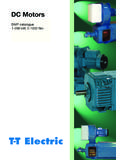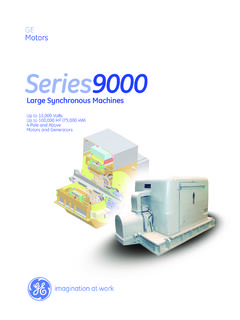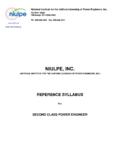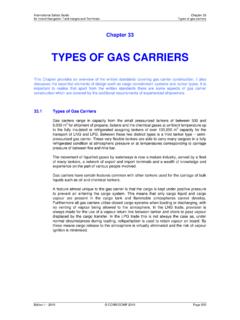Transcription of MECHANICAL STABILITY OF CEMENT ROTARY …
1 1 MECHANICAL STABILITY OF CEMENT ROTARY KILNS TO PREVENT BRICK LINING FAILURE by Dalela, Raju Goyal and Kamal Kumar HOLTEC CONSULTING PRIVATE LIMITED, NEW DELHI SUMMARY The productivity in a CEMENT plant mainly depends upon the availability of the kiln. The present day ROTARY kilns are having large diameter and it is most essential to maintain their MECHANICAL STABILITY . The kiln alignment, deformation of shell, ovality, etc. are some of the factors which play an important role in maintaining the good refractory life. In this paper, an attempt has been made to analyse the causes of refractory lining failure, specially with reference to MECHANICAL stresses on bricklining.
2 INTRODUCTION The CEMENT production all over the world including India is growing very fast to match the demand & supply pressure in the market. The market of CEMENT sales is very competitive that is why the profit margin has very narrow band between production and sales. Any type of interruption in production of CEMENT can affect the profitability. Kiln is the most crucial equipment of CEMENT manufacturing process and the productivity largely depends on the kiln operation and its availability. In the past experience, it is observed that the main interruption in CEMENT production is due to the failure of refractory.
3 The statistical data show that the refractory failure has around 80% contribution in total kiln down time as shown in figure 1. The investigations show that the causes of refractory failure and poor durability of refractory in large diameter kilns are due to the following factors. Grade & lining methods of refractory Operational influence MECHANICAL stresses on the refractory. The grade and lining methods of refractory and kiln operation in ROTARY kiln have undergone considerable changes in recent past. With the development of various new generation refractory bricks and technological upgradations, significant improvement in the service life of kiln refractory is being experienced.
4 The paper discusses the causes of refractory lining failure with reference to MECHANICAL stresses which are due to the following factors: Kiln shell ovality 2 Kiln shell warping Kiln alignment MECHANICAL condition of kiln KILN SHELL OVALITY Terminologies The refractory life in the area of kiln tyre is significantly influenced by kiln deformation , the shell ovality. As a result of changes in the kiln shell radius, there is a movement between the bricks which results in local surface pressure which leads to rapid wear or the collapse of the lining.
5 For proper understanding of subject the terminologies such as creep, tyre clearance and ovality are explained below: Creep Figure 2 indicates cylindrical, undeformed tyre having inside diameter as Do and undeformed outside diameter of kiln shell, above chairs, as do .The theoretical clearance between the two perfect cylinders is C . During each revolution there is a relative movement U between the tyre and the shell which is equal to the difference of the circumference which is called as creep and is defined below. U = x (Do - do) = x C or C = U Tyre Clearance During operation, the tyre is deformed due to the station load and becomes elliptical as shown, in exaggerated manner, in figure 3.
6 The horizontal inside diameter of tyre is Dh and vertical inside diameter as Dv . The shell inside the tyre has an outside horizontal diameter of Dh (equal to inside diameter of tyre) but the vertical diameter is smaller than Dv by a gap S , called tyre clearance. Ovality Ovality is the cross sectional deformation of the kiln shell during each revolution in the region X to Y as shown in figure 3 and can be measured by Holderbank s Shell Test Apparatus . It produces a polar diagram which represents the cross section of the kiln during operation.
7 A typical polar diagram is shown in figure 4. With the help of a polar diagram, absolute and relative ovalities are calculated by the following formulae. 3 Wa = 43 d (mm) 2 Wr = 43 ddN 100 (%)2 Where = '15 Actual Deformation = Deformation measured from polar diagram 15 = Equipment constant (In old equipment, it was 10) d = External diameter of kiln shell in meters dN = Internal diameter of kiln shell in mm Wa = Absolute ovality Wr = Relative ovality To prevent rapid wear of brick lining, the relative ovality should be kept within the reasonable limits.
8 Figure 5 indicates relative ovality limits as a function of kiln diameter. It is observed that for a kiln of 3 m diameter the relative ovality should be around whereas for a kiln of 6 m diameter, it should be around Measurement of Creep and Tyre Clearance With loose tyres the monitoring of creep and tyre clearance is important, which can simultaneously be measured with a simple device shown in figure 6. It consists of a pointer and a recording plate. The pointer is attached to the kiln shell by a magnet and pressed in contact with the recording plate which is secured with help of a magnet on to the tyre.
9 The creep U and the tyre clearance S can be read directly from the plotted profile. If above instrument is not available the creep can be determined by suitably marking tyre and the shell and then by measuring displacement between tyre and shell. Theoretically U = x S but practically U = 2 x S only. It is recommended that a tyre clearance of 3 to 4 mm (creep of 6-8 mm) should always be maintained for proper floating of tyre. Effect of temperature on Tyre Clearance In case the shell under tyre is overheated, or heated rapidly during startup, clearance S starts reducing and in case the shell is heated further, it becomes zero.
10 If the shell is further heated, it results in the constriction of shell seizing of shell with the tyre as also the shell can be pinched inside, damaging the kiln shell permanently. Typically the difference in temperature between shell and tyre must 4 not increase 150oC. In case this temperature difference increases more than 150oC, shell should be cooled down by the cooling fan as shown in figure 7. The fan has to be so arranged that the cooling air passes through the gap between two consecutive chairs. To avoid undesirable eventualities of shell seizure, a system for monitoring the creep of the floating tyre continuously, with an alarm and cooling system can be installed.









